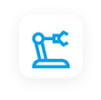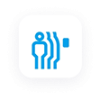Automation is continuously becoming an indispensable part of factories and warehouses for its ability to enhance productivity. Robots and cobots are being increasingly adopted and are poised to play a crucial role in running smart factories. However, the increasing use of heavy machines and automated systems can also cause fatal accidents in smart warehouses.
The injuries resulting from contact with objects and equipment installed at a factory are the third leading cause of work-related death. It’s largely because no or minimal efforts are made to protect the personnel who work in complex factory environments and machines.
Many businesses install mat switches, light curtains, and safety fences, but all of these solutions have limitations. So, what other option do you have? Safety laser scanners are by far the most reliable perimeter guarding tools for any factory.
Understanding Safety Laser Scanners
A safety laser scanner uses infrared lasers to detect a human or object approaching a hazardous area, machinery, or equipment. If the safety laser scanner detects a subject, it sends a pause or stop signal to the paired machinery.
One premiere model is the Hokuyo UAM-05LP safety laser scanner. Notably, its compact size makes attaching it anywhere easier, including tight spaces within robotic cells or moving autonomous vehicles. Additionally, the configurable 5-meter safety zone and up to 20-meter warning area provide extensive coverage.
Applications of Safety Laser Scanners
The typical safety measures employed in smart factories with industrial robots include fencing off robot workspaces and combining these fences with movable guard door switches or light curtains. However, these preventive measures mainly focus on intrusion risks.
When Using Robots
For instance, in a scenario where a robot needs to extend its arm beyond the fence to pick up a part, it may go unalarmed for personnel, thus increasing the chances of collision. However, by using safety laser scanners, you can program two zones:
- Safety Zone: You program the scanner to create a smaller zone, let’s say of 5 meters, that will be closer to the robot. If a worker steps inside this safety zone, the scanner will trigger the stop signal, and the robot will stop.
- Warning Zone: This area extends beyond the physical fence, and the scanner will be configured for a range beyond the Safety Zone. If someone enters this zone, the scanner will trigger a warning signal. Also, the robot will stop functioning until the worker leaves that area. Therefore, the robots or cobots can extend their reach to pick up anything outside the fenced area without hurting any human worker.
During Welding
Consider a welding application where personnel frequently move the robotic arms. To safeguard the worker in this case, you can use a safety laser scanner to create a virtual boundary around the welding area. When the robotic arm extends outside that safety zone or when a worker enters that zone, the robot stops operating.
During Palletizing
For palletizing, the scanner can monitor the movement of heavy loads and stop the process if a worker is detected too close to it.
During Residual Presence
Because of their fixed monitoring areas, you can’t achieve accuracy when using light curtains or mat switches to detect residual presence. In contrast, safety laser scanners provide you the flexibility to configure for covering different areas.
When Using Cobots
In the case of collaborative robots (cobots), the role of the safety laser scanner becomes even more crucial. This is because cobots are designed to work alongside human workers. Most commonly, they are employed in existing production lines to assist personnel in lifting, carrying, and positioning heavy items. Although the payload is not as heavy as the one lifted by robots, it still poses a threat to workers when handling sharp or hazardous items.
In such scenarios, you can install safety laser scanners like the Hokuyo UAM-05LP with a 270° wide detection range. When it detects the workers approaching the cobot or its workpiece, it will send a message to the robot to slow down or stop before any contact occurs.
Safety Laser Scanners for Accident-Free Workplace
The integration of industrial and collaborative robots in the manufacturing sector is snowballing. The adoption is gaining momentum, especially in cutting costs, enhancing overall productivity, and improving production standards. However, this growth also undermines the critical requirement for implementing solid security measures to protect workers from potential hazards.
Hokuyo understands this situation and dedicates itself to building innovative safety laser scanners, LiDAR sensors, and more. We keep ourselves updated with industry-specific trends continuously and create solutions that speak for themselves. Each product we design and develop has the purpose of solving your problems.
Contact us to learn more about safety laser scanners and how you can use them to keep your workers safe.

 Factory Automation
Factory Automation Logistics Automation
Logistics Automation Process Automation
Process Automation Crane Collision Avoidance
Crane Collision Avoidance LiDAR/Obstacle Detection
LiDAR/Obstacle Detection Safety Laser Scanners
Safety Laser Scanners Optical Data Transmission
Optical Data Transmission Hot Metal Detectors
Hot Metal Detectors Laser Distance Sensor
Laser Distance Sensor Blog
Blog Whitepapers
Whitepapers Case Studies
Case Studies Infographics
Infographics